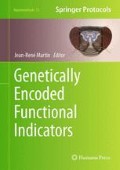Abstract
Genetically encoded calcium indicators make it possible to track neural activity on a population-wide level. Here we describe a preparation that enables two-photon imaging of neural activity in an essentially intact fly. We present strategies to minimize motion of the brain, both in preparation technique and in apparatus design. We discuss key variables for reducing the problems of photobleaching and phototoxicity in order to collect high quality imaging data. Finally, we discuss approaches to analyze the large quantities of data that can now be readily acquired using the latest generation of genetically encoded calcium indicators.
Access this chapter
Tax calculation will be finalised at checkout
Purchases are for personal use only
References
Malnic B, Hirono J, Sato T, Buck LB (1999) Combinatorial receptor codes for odors. Cell 96:713–723
Su C-Y, Menuz K, Carlson JR (2009) Olfactory perception: receptors, cells, and circuits. Cell 139:45–59
Marder E, Bucher D (2007) Understanding circuit dynamics using the stomatogastric nervous system of lobsters and crabs. Annu Rev Physiol 69:291–316
Reiff DF, Ihring A, Guerrero G, Isacoff EY, Joesch M, Nakai J, Borst A (2005) In vivo performance of genetically encoded indicators of neural activity in flies. J Neurosci 25:4766–4778
Tian L, Hires SA, Mao T, Huber D, Chiappe ME, Chalasani SH, Petreanu L, Akerboom J, McKinney SA, Schreiter ER, Bargmann CI, Jayaraman V, Svoboda K, Looger LL (2009) Imaging neural activity in worms, flies and mice with improved GCaMP calcium indicators. Nat Methods 6:875–881
Miyawaki A, Llopis J, Heim R, McCaffery JM, Adams JA, Ikura M, Tsien RY (1997) Fluorescent indicators for Ca2+ based on green fluorescent proteins and calmodulin. Nature 388:882–887
Mank M, Santos AF, Direnberger S, Mrsic-Flogel TD, Hofer SB, Stein V, Hendel T, Reiff DF, Levelt C, Borst A, Bonhoeffer T, Hübener M, Griesbeck O (2008) A genetically encoded calcium indicator for chronic in vivo two-photon imaging. Nat Methods 5:805–811
Brand AH, Perrion N (1993) Targeted gene expression as a means of altering cell fates and generating dominant phenotypes. Development 118:401–415
Lai S-L, Lee T (2006) Genetic mosaic with dual binary transcriptional systems in Drosophila. Nat Neurosci 9:703–709
Potter CJ, Tasic B, Russler EV, Liang L, Luo L (2010) The Q system: a repressible binary system for transgene expression, lineage tracing, and mosaic analysis. Cell 141:536–548
Mank M, Griesbeck O (2008) Genetically encoded calcium indicators. Chem Rev 108:1550–1564
Stosiek C, Garaschuk O, Holthoff K, Konnerth A (2003) In vivo two-photon calcium imaging of neuronal networks. Proc Natl Acad Sci USA 100:7319–7324
Davis RL (2005) Olfactory memory formation in Drosophila: from molecular to systems neuroscience. Annu Rev Neurosci 28:275–302
Keene A, Waddell S (2007) Drosophila olfactory memory: single genes to complex neural circuits. Nat Rev Neurosci 8:341–354
Perez-Orive J, Mazor O, Turner GC, Cassenaer S, Wilson RI, Laurent G (2002) Oscillations and sparsening of odor representations in the mushroom body. Science 297:359–365
Turner GC, Bazhenov M, Laurent G (2008) Olfactory representations by Drosophila mushroom body neurons. J Neurophysiol 99:734–746
Kanerva P (1988) Sparse distributed memory. MIT Press, Cambridge, MA
Marr D (1969) A theory of cerebellar cortex. J Physiol (Lond) 202:437–470
Yuste R (2005) Imaging in neuroscience and development: a laboratory manual. Cold Spring Harbor Laboratory Press, Cold Spring Harbor, NY
Grewe BF, Helmchen F (2009) Optical probing of neuronal ensemble activity. Curr Opin Neurobiol 19:520–529
Helmchen F, Denk W (2005) Deep tissue two-photon microscopy. Nat Methods 2:932–940
Oertner TG, Single S, Borst A (1999) Separation of voltage- and ligand-gated calcium influx in locust neurons by optical imaging. Neurosci Lett 274:95–98
Single S, Borst A (2002) Different mechanisms of calcium entry within different dendritic compartments. J Neurophysiol 87:1616–1624
Wang Y, Wright NJ, Guo H, Xie Z, Svoboda K, Malinow R, Smith DP, Zhong Y (2001) Genetic manipulation of the odor-evoked distributed neural activity in the Drosophila mushroom body. Neuron 29:267–276
Wang Y, Guo H-F, Pologruto TA, Hannan F, Hakker I, Svoboda K, Zhong Y (2004) Stereotyped odor-evoked activity in the mushroom body of Drosophila revealed by green fluorescent protein-based Ca2+ imaging. J Neurosci 24:6507–6514
Jayaraman V, Laurent G (2007) Evaluating a genetically encoded optical sensor of neural activity using electrophysiology in intact adult fruit flies. Front Neural Circ 1:3
Yaksi E, Friedrich RW (2006) Reconstruction of firing rate changes across neuronal populations by temporally deconvolved Ca2+ imaging. Nat Methods 3:377–383
Murthy M, Turner GC (2010) In vivo whole-cell recordings in the Drosophila brain. In: Zhang B, Waddell S, Freeman M (eds) Drosophila neurobiology methods: a laboratory manual. Cold Spring Harbor Laboratory Press, Cold Spring Harbor, NY
Wang JW, Wong AM, Flores J, Vosshall LB, Axel R (2003) Two-photon calcium imaging reveals an odor-evoked map of activity in the fly brain. Cell 112:271–282
Bate M (1993) The development of Drosophila melanogaster. Cold Spring Harbor Laboratory Press, Cold Spring Harbor, NY
Seelig JD, Chiappe ME, Lott GK, Dutta A, Osborne JE, Reiser MB, Jayaraman V (2010) Two-photon calcium imaging from head-fixed Drosophila during optomotor walking behavior. Nat Methods 7:535–540
Guizar-Sicairos M, Thurman ST, Fienup JR (2008) Efficient subpixel image registration algorithms. Opt Lett 33:156–158
Acknowledgments
K.S.H. is supported by the Crick-Clay fellowship from the Watson School of Biological Sciences and predoctoral training grant 5T32GM065094 from the National Institute of General Medical Sciences. E.G. is supported by the Elisabeth Sloan Livingston fellowship from the Watson School of Biological Sciences. This work was funded by NIH grant R01 DC010403-01A1.
Author information
Authors and Affiliations
Corresponding author
Editor information
Editors and Affiliations
Rights and permissions
Copyright information
© 2012 Springer Science+Business Media, LLC
About this protocol
Cite this protocol
Campbell, R.A.A., Honegger, K.S., Gruntman, E., Turner, G.C. (2012). Two-Photon Imaging of Population Activity with Genetically Encoded Calcium Indicators in Living Flies. In: Martin, JR. (eds) Genetically Encoded Functional Indicators. Neuromethods, vol 72. Humana Press, Totowa, NJ. https://doi.org/10.1007/978-1-62703-014-4_7
Download citation
DOI: https://doi.org/10.1007/978-1-62703-014-4_7
Published:
Publisher Name: Humana Press, Totowa, NJ
Print ISBN: 978-1-62703-013-7
Online ISBN: 978-1-62703-014-4
eBook Packages: Springer Protocols

